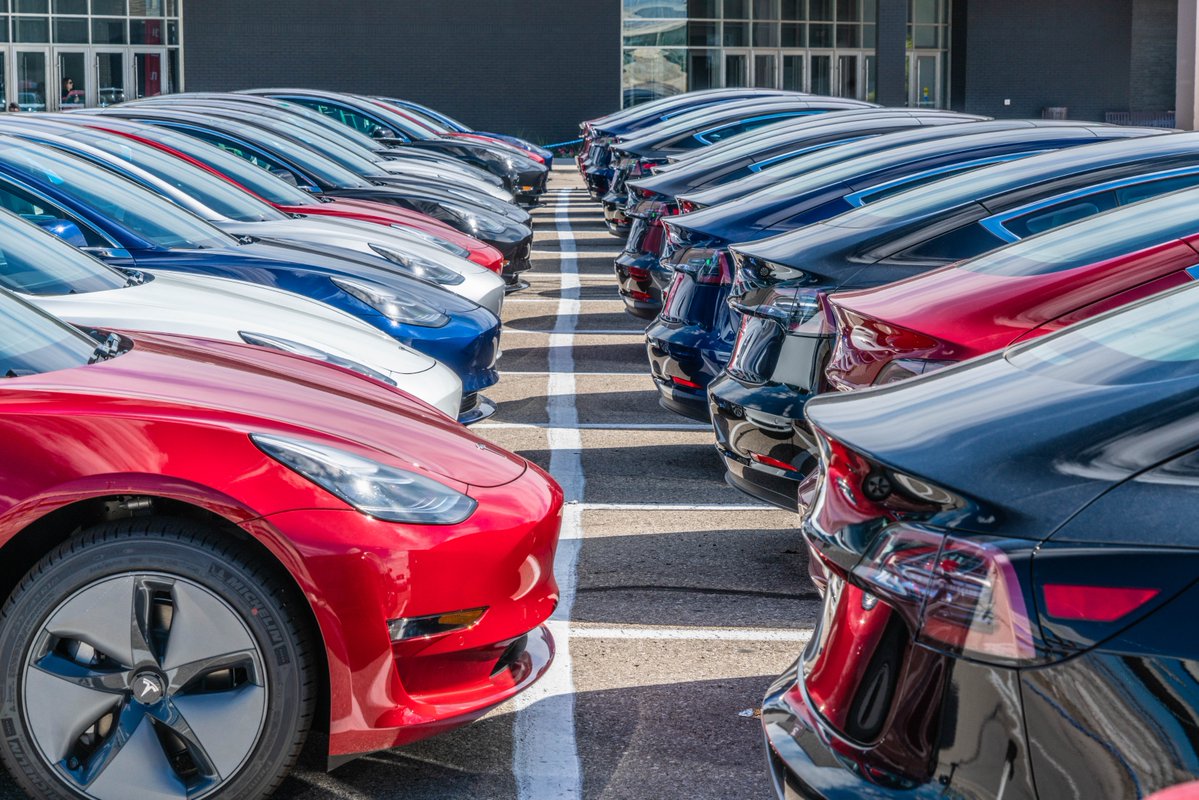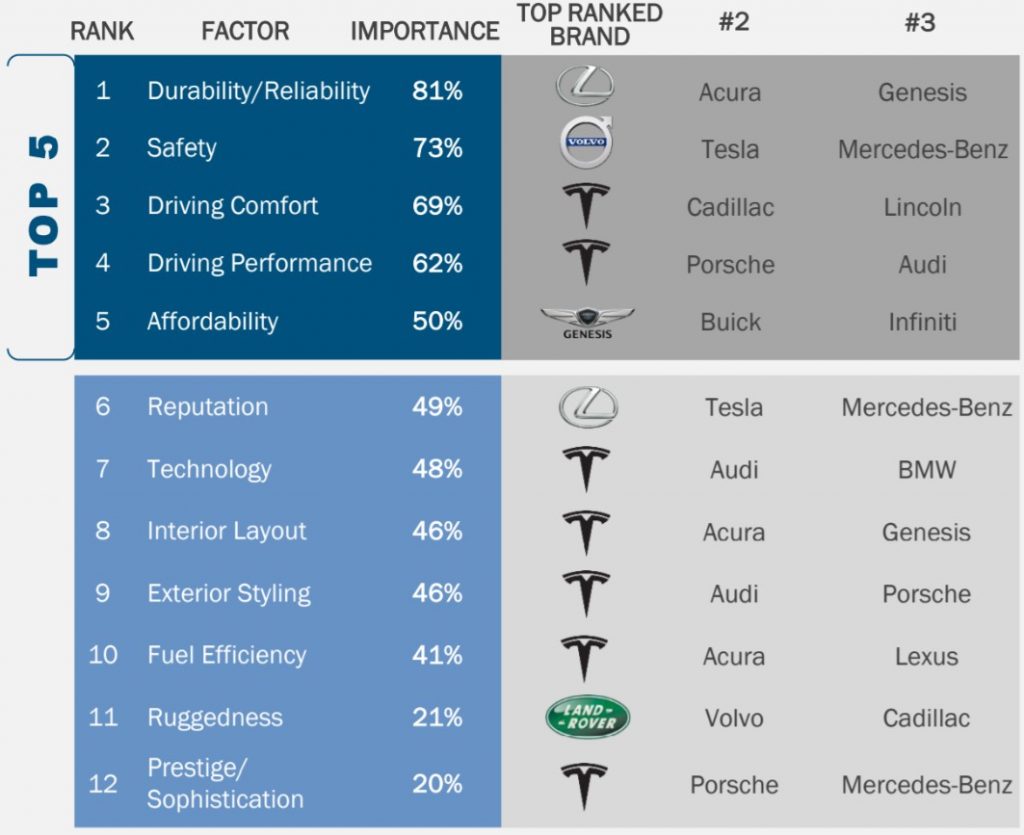

Investor's Corner
Tesla dominates US luxury car segment in Kelly Blue Book’s Q2 2019 Brand Watch
The results of the Q2 2019 Kelley Blue Book Brand Watch have revealed that the United States’ luxury vehicle segment is being dominated by Tesla, particularly its most disruptive vehicle to date, the Model 3 midsize sedan.
As per the results of KBB’s recent report, the Tesla Model 3 was the most-considered luxury model in Q2 2019, up from No.6 in the first quarter. Even the Model S, a vehicle that has seen a decline in sales amidst the ongoing ramp of the Model 3, ranked well in KBB’s study, holding the No.8 spot on the most-shopped luxury vehicle list.
Tesla was the sixth overall most-shopped luxury brand in the United States, with 14% of luxury vehicle shoppers considering one of the company’s existing offerings when purchasing a premium vehicle. This is a notable improvement from Tesla’s first-quarter results, which saw the company ranking 10th with 8% of luxury car shoppers considering a Model 3, Model S, or Model X.

Tesla’s results from the Q2 2019 Kelley Blue Book Brand Watch are particularly impressive, especially considering that the company encountered challenges during the second quarter. Following lower-than-expected deliveries in Q1, Tesla was hit by a wave of negative sentiments that ranged from the alleged lack of demand for the Model 3 to a plummeting stock price. If the results of the KBB report are any indication, it appears that the notable negativity that surrounded Tesla in the second quarter did little to dent the company’s reputation among car buyers.
This is particularly notable in the fact that Tesla also dominated the list of most important factors for consumers that are looking to purchase a vehicle, with the electric car maker capturing seven first-place spots out of 12 categories outlined in the report. As per KBB’s results, Tesla was considered as the top-ranked brand for driving comfort, driving performance, technology, interior layout, exterior styling, fuel efficiency, and prestige/sophistication.

With these results, Kelley Blue Book noted that Tesla has now grown into one of the most formidable luxury brands in the United States. “Tesla is no longer an emerging brand, it has become one of the top performing luxury brands with 8% market share,” the KBB report noted.
Ultimately, the only categories in the Q2 2019 Kelley Blue Book Brand Watch where Tesla did not place in the top three spots included ruggedness, which is so far irrelevant to the brand considering that the company has no off-road vehicle to date; as well as affordability, which is only somewhat important for the mainstream-priced Tesla Model 3. Both these categories will likely be addressed by Tesla in the near future, with the Tesla Pickup Truck potentially catering to the rugged, utilitarian market, and Model 3 prices being further optimized amidst dropping battery prices.
The full results of the Q2 2019 Kelley Blue Book Brand Watch could be found below.
2019Q2 Brand Watch Luxury Topline by Simon Alvarez on Scribd

Investor's Corner
Tesla stock closes at all-time high on heels of Robotaxi progress

Tesla stock (NASDAQ: TSLA) closed at an all-time high on Tuesday, jumping over 3 percent during the day and finishing at $489.88.
The price beats the previous record close, which was $479.86.
Shares have had a crazy year, dipping more than 40 percent from the start of the year. The stock then started to recover once again around late April, when its price started to climb back up from the low $200 level.
This week, Tesla started to climb toward its highest levels ever, as it was revealed on Sunday that the company was testing driverless Robotaxis in Austin. The spike in value pushed the company’s valuation to $1.63 trillion.
Tesla Robotaxi goes driverless as Musk confirms Safety Monitor removal testing
It is the seventh-most valuable company on the market currently, trailing Nvidia, Apple, Alphabet (Google), Microsoft, Amazon, and Meta.
Shares closed up $14.57 today, up over 3 percent.
The stock has gone through a lot this year, as previously mentioned. Shares tumbled in Q1 due to CEO Elon Musk’s involvement with the Department of Government Efficiency (DOGE), which pulled his attention away from his companies and left a major overhang on their valuations.
However, things started to rebound halfway through the year, and as the government started to phase out the $7,500 tax credit, demand spiked as consumers tried to take advantage of it.
Q3 deliveries were the highest in company history, and Tesla responded to the loss of the tax credit with the launch of the Model 3 and Model Y Standard.
Additionally, analysts have announced high expectations this week for the company on Wall Street as Robotaxi continues to be the focus. With autonomy within Tesla’s sights, things are moving in the direction of Robotaxi being a major catalyst for growth on the Street in the coming year.
Elon Musk
Tesla needs to come through on this one Robotaxi metric, analyst says
“We think the key focus from here will be how fast Tesla can scale driverless operations (including if Tesla’s approach to software/hardware allows it to scale significantly faster than competitors, as the company has argued), and on profitability.”

Tesla needs to come through on this one Robotaxi metric, Mark Delaney of Goldman Sachs says.
Tesla is in the process of rolling out its Robotaxi platform to areas outside of Austin and the California Bay Area. It has plans to launch in five additional cities, including Houston, Dallas, Miami, Las Vegas, and Phoenix.
However, the company’s expansion is not what the focus needs to be, according to Delaney. It’s the speed of deployment.
The analyst said:
“We think the key focus from here will be how fast Tesla can scale driverless operations (including if Tesla’s approach to software/hardware allows it to scale significantly faster than competitors, as the company has argued), and on profitability.”
Profitability will come as the Robotaxi fleet expands. Making that money will be dependent on when Tesla can initiate rides in more areas, giving more customers access to the program.
There are some additional things that the company needs to make happen ahead of the major Robotaxi expansion, one of those things is launching driverless rides in Austin, the first city in which it launched the program.
This week, Tesla started testing driverless Robotaxi rides in Austin, as two different Model Y units were spotted with no occupants, a huge step in the company’s plans for the ride-sharing platform.
Tesla Robotaxi goes driverless as Musk confirms Safety Monitor removal testing
CEO Elon Musk has been hoping to remove Safety Monitors from Robotaxis in Austin for several months, first mentioning the plan to have them out by the end of 2025 in September. He confirmed on Sunday that Tesla had officially removed vehicle occupants and started testing truly unsupervised rides.
Although Safety Monitors in Austin have been sitting in the passenger’s seat, they have still had the ability to override things in case of an emergency. After all, the ultimate goal was safety and avoiding any accidents or injuries.
Goldman Sachs reiterated its ‘Neutral’ rating and its $400 price target. Delaney said, “Tesla is making progress with its autonomous technology,” and recent developments make it evident that this is true.
Investor's Corner
Tesla gets bold Robotaxi prediction from Wall Street firm
Last week, Andrew Percoco took over Tesla analysis for Morgan Stanley from Adam Jonas, who covered the stock for years. Percoco seems to be less optimistic and bullish on Tesla shares, while still being fair and balanced in his analysis.

Tesla (NASDAQ: TSLA) received a bold Robotaxi prediction from Morgan Stanley, which anticipates a dramatic increase in the size of the company’s autonomous ride-hailing suite in the coming years.
Last week, Andrew Percoco took over Tesla analysis for Morgan Stanley from Adam Jonas, who covered the stock for years. Percoco seems to be less optimistic and bullish on Tesla shares, while still being fair and balanced in his analysis.
Percoco dug into the Robotaxi fleet and its expansion in the coming years in his latest note, released on Tuesday. The firm expects Tesla to increase the Robotaxi fleet size to 1,000 vehicles in 2026. However, that’s small-scale compared to what they expect from Tesla in a decade.
Tesla expands Robotaxi app access once again, this time on a global scale
By 2035, Morgan Stanley believes there will be one million Robotaxis on the road across multiple cities, a major jump and a considerable fleet size. We assume this means the fleet of vehicles Tesla will operate internally, and not including passenger-owned vehicles that could be added through software updates.
He also listed three specific catalysts that investors should pay attention to, as these will represent the company being on track to achieve its Robotaxi dreams:
- Opening Robotaxi to the public without a Safety Monitor. Timing is unclear, but it appears that Tesla is getting closer by the day.
- Improvement in safety metrics without the Safety Monitor. Tesla’s ability to improve its safety metrics as it scales miles driven without the Safety Monitor is imperative as it looks to scale in new states and cities in 2026.
- Cybercab start of production, targeted for April 2026. Tesla’s Cybercab is a purpose-built vehicle (no steering wheel or pedals, only two seats) that is expected to be produced through its state-of-the-art unboxed manufacturing process, offering further cost reductions and thus accelerating adoption over time.
Robotaxi stands to be one of Tesla’s most significant revenue contributors, especially as the company plans to continue expanding its ride-hailing service across the world in the coming years.
Its current deployment strategy is controlled and conservative to avoid any drastic and potentially program-ruining incidents.
So far, the program, which is active in Austin and the California Bay Area, has been widely successful.








